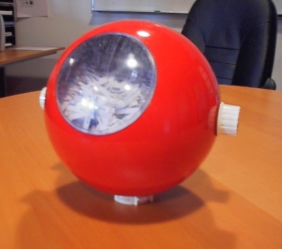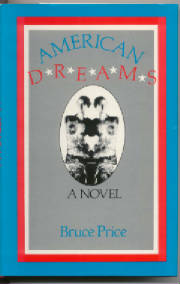In the 1920s Andre Breton and Surrealism celebrated the subconscious. Breton said we must listen to our dreams, not our conscious
thoughts. To me this is a tiresome debate. What’s clear is that ordinary people go to sleep every night and dream astonishingly
original stuff they couldn’t come up with consciously. Clearly the subconscious is a second source you can call on--if
it works for you, use it. And I suggest that chance is a third source. (If chance is too Las-Vegas for you, call it serendipity!)
Here’s an experiment intended to tie all this up in a neat package. Take paper and pencil (yes, you writers, too) and
draw the most interesting abstract you can in five minutes. Now, do the same in a room without any light. (Turn the paper
so you don’t even know what’s up or down.) I bet the blind drawing is going to be comparable most of the time.
Can we use the word skill, when there’s no feedback for the eyes? Can we talk about dreams or the subconscious? I think
we have to allow for a big dose of you and chance dancing cheek to cheek.
I read an article about a sculptress (actually she was an arty ceramacist) who said: “Sometimes, the most interesting
pieces come from a series of guided accidents.” Exactly!! What happens is you try to let interesting things happen and
then you stand by like a midwife and catch the baby....Surely skill guides some of that guiding. Maybe the subconscious plays
a role. And part of it is that you toss the dice and hope to get very lucky.

Around 1975 a man named Edward de Bono announced a device he called The Think Tank, a plastic globe with 13,000 words on little
plastic strips. You roll the globe to expose new words in a small window; then you were supposed to brainstorm your way to
a creative victory. I loved this device; I wanted one. But the price was too high for a poor writer. Eureka! I realized I
could generate random numbers with my calculator, let the numbers indicate pages in my dictionary, and then with my eyes closed,
pick a random word. Then I’d ad lib the most interesting sentence with that word in it; and wing it as long as I could.
Using this technique, I wrote a lot of poetry. Surrealism? Automatic writing? Or just forcing my overly intellectual brain
to stay light and loose? Let’s not waste time arguing. The only thing that matters is this: was the poetry any good?
Some of it was, I’ll go that far. More to the point, some of it was better than what I was writing before this experiment.
Something else happened. I became addicted to that rootless, thoughtless freedom when the new word comes up. I recklessly
decided I would try to write a whole novel this way. I imagined that I’d need to pop a new word every few paragraphs
to keep it going. But what happened was, the words suggested story and I ran with each story as many pages as I could. The
first word was disclosure, and the first sentence was: “He decided to make a full disclosure.” I saw a man about
to confess to his wife....
The next night I drew another word. And the next night. The writing was quite good, but I was creating new people and
new stories at an unruly clip. Finally I assigned them all numbers and randomly determined who intersected with whom. Like
happy endings? This extreme experiment became American Dreams, published by Permanent Press in 1985, favorably reviewed by
Publishers Weekly, and still available. There’s no mention in the book of the technique used. Who’d believe it?
But I always felt that American Dreams would be a top contender for Great American Experimental Novel. So, where did all that
material came from? Same place dreams come from, I suppose. (You see that the title had a double meaning for me.) But unlike
the Surrealists, I never argued that one place is better than another. I’ve written other novels the old-fashioned way
where you plan everything. Much, much safer!

HEMINGWAY SAID WHAT??
Perhaps the best art comes from a zone between partly planned and partly footloose. The most amazing thing I ever read about
any writer was the comment attributed to Hemingway. He claimed he never set out to write a novel. He wrote short stories but
some of them wouldn’t stop. I once interviewed a novelist (he was semi-famous at the time) who told me he wrote a page
each day and put the pages in a box in a drawer. At the end of the year, he sent the manuscript to his publisher!
The thread running through all this is that sometimes you need to give up some control. Let go. What else was Jackson Pollack
doing with those dripping brushes? He was tossing paint at the canvas, mostly in control but not entirely. The art was looser
and more spontaneous than his earlier work--and better.
I understand completely. If I could throw paint against a wall and make beauty, that’d be my genre. Around 1990 I did
a long series of paintings called “Poems” where planning was not allowed. I’d start with a blank, Zen-like
mind and, shazam, create the most interesting and unexpected element I could put on the canvas...and then the next most interesting...If
I could create five or six surprising elements, I’d have a good piece.
I suspect that Franz Klein, when doing the famous action paintings, was in this same zone. I bet a lot of them were ugly and
he threw them away. The ones with that offhand, what-a genius quality, he showed to the world.
The main thing is not to fear failing. Take risks and see what happens. The big challenge is to stifle your practical, critical,
intellectual side until the art is done. Then wake up that dour, annoying fellow and see what he has to say.
Creative block is usually
caused by too much thinking and straining. Make sure you’re creating stuff that you like creating--so that it’s
fun. In a cool period, try warming up by doing an extreme version of your medium. In the case of writing, go with sex or violence
or emotional moments. Churn out scenes as fast as you can type. Write with abandon in whatever direction you fancy, and maybe
in the torrent of words you’ll rediscover the joy of writing.
Having fun (or trying to) and creating on
the edge--that’s pretty much my MO. Now I’m doing those same things as a digital painter. You might wonder, aren’t
computers just machines--rigid and inhuman? How do they fit in with being wild and creative? The answer has two parts. First
is speed--the computer lets me explore a lot of roads quickly. Second is originality--the computer lets me make a flood of
startling stuff. Honestly, if I could draw like Michealangelo, I’d better do just that. I can’t. What I have is
a flair for design, a flair for color; I know what I like. So I create a lot of elements and look for magical synergies. Often,
I assemble the pieces a la Rauschenberg, David Salle or Rosenquist, so that the total energy is greater than any of the parts.
Exactly as with the “Poems” 15 years ago, I stay busy, try to stay loose, and wait for the keepers to show up.
A series of guided accidents, all of them!
I’ve seen books that suggest different kinds of experiments.
But note well: an experiment is a cold thing unless it taps into your hot core. Which brings us to the final advice: devise
the techniques, find the experiments, and cause the accidents that maximize your creativity. Whatever works!
Article 10>>>"MAX
Your Creativity" first appeared on CREATIVITY-PORTAL.COM in 2005.
--"American Dreams" can be
obtained by going to WWW.THEPERMANENTPRESS.COM (Backlist). Also available on Amazon as e-book and other formats. See reviews on Amazon.
--examples of digital art can be seen on ArtNorfolk.com (Price's art site)
--examples of experimental
writing can be found on Lit4u.com